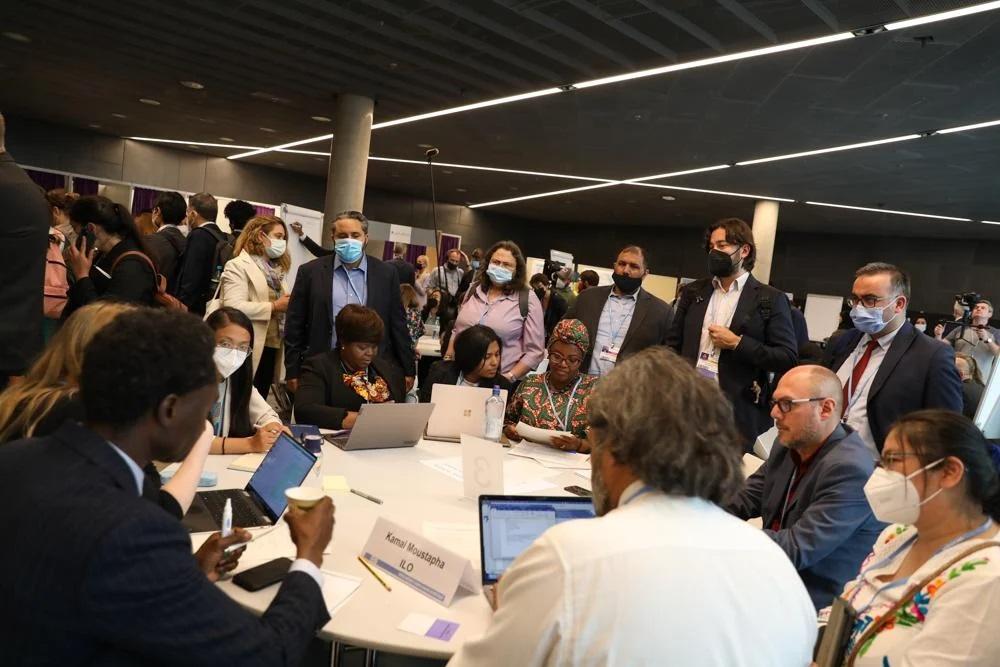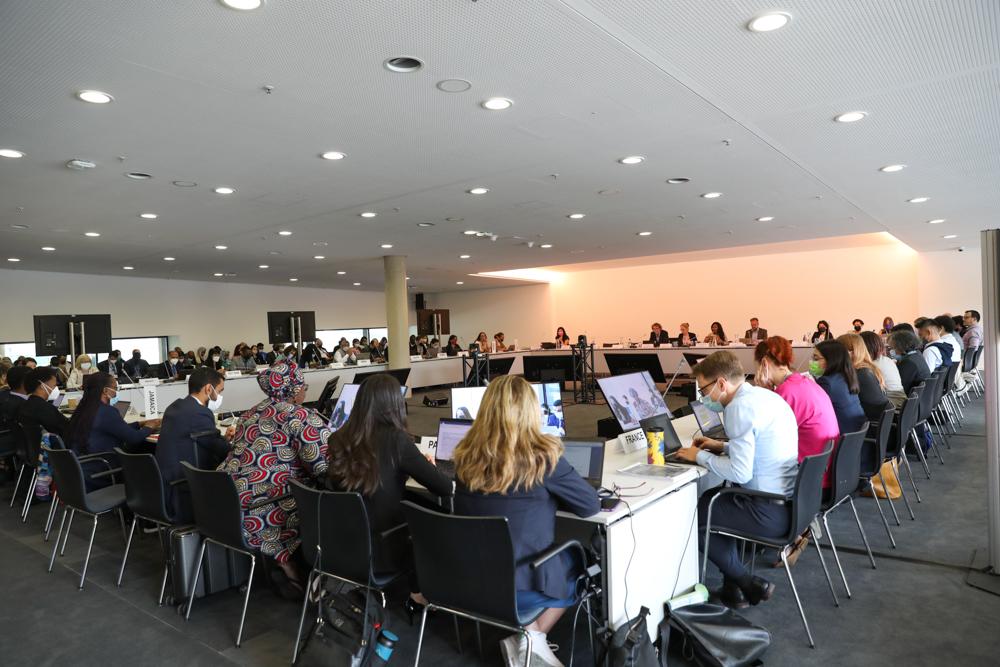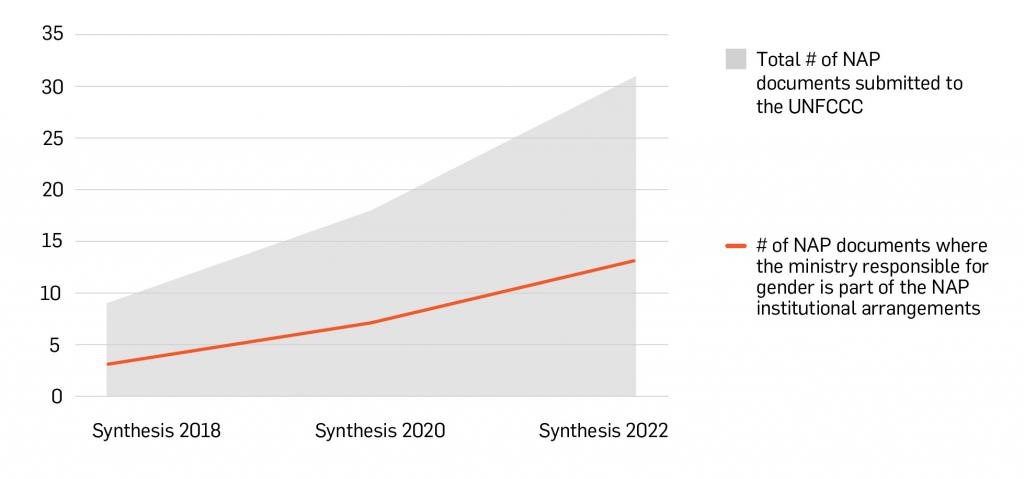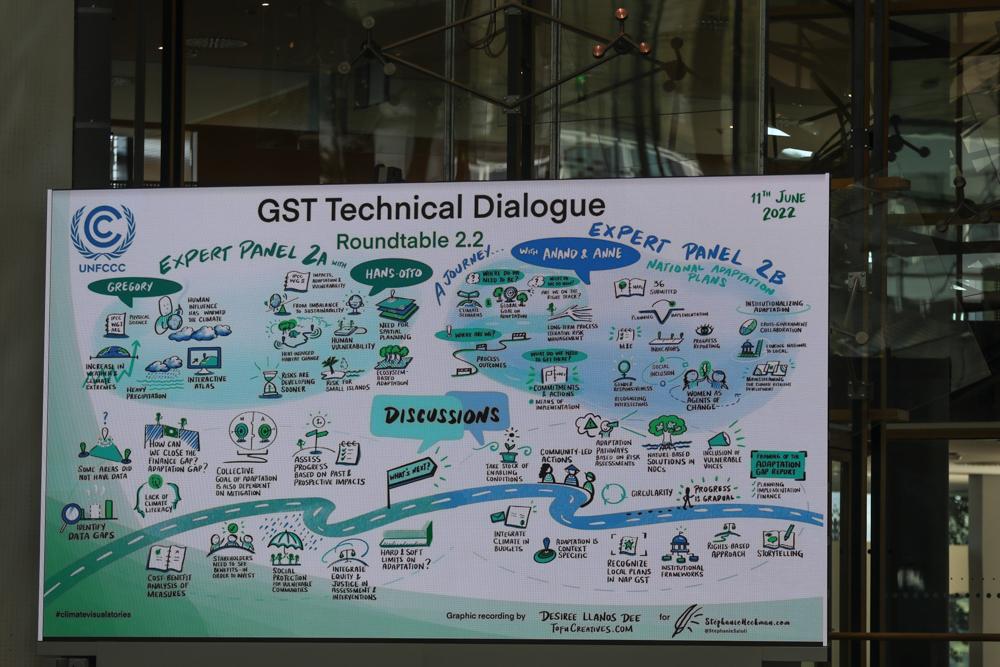What We Heard From the Global Stocktake's First Technical Dialogue on Adaptation
June’s Bonn Climate Change Conference kickstarted an important part of the inaugural 2-year Global Stocktake under the Paris Agreement. What did participants say about climate change adaptation during the Global Stocktake’s first Technical Dialogue, and what does it mean for global adaptation ambition?
When it comes to global climate action, we are falling dangerously behind the level of ambition that scientists are urging us to reach. As the United Nations Framework Convention on Climate Change (UNFCCC) process makes the transition from the negotiation to the implementation of the landmark Paris Agreement, countries began taking stock of the progress they have made so far and asking what more the world should be doing to tackle the climate crisis.
At the heart of the Paris Agreement, the Global Stocktake (GST) can be understood as a periodic review mechanism for both climate mitigation and adaptation. The first GST concludes in 2023, involving a 2-year process that brings together climate change experts, decision-makers, practitioners, and civil society stakeholders to assess the world’s collective progress in meeting the long-term goals of the Paris Agreement. The GST will then take place every 5 years. The outputs of each GST—which is envisioned to be a set of policy-relevant recommendations—will then help countries update their Nationally Determined Contributions, as well as other climate action plans such as the National Adaptation Plans (NAPs), with the intention that each update is grounded in the best-available science and will be more ambitious than previous ones.
When we talk about the Paris Agreement’s long-term goals, we usually think of the 1.5°C and 2 °C temperature goals—but there is more than that. The GST takes stock of more than the world’s collective progress toward mitigation—it also measures progress in adapting to climate change impacts, increasing adaptive capacity, strengthening resilience, and reducing vulnerabilities.
The Technical Dialogues: Building a shared understanding
The recently concluded Bonn Climate Change Conference (SB56) kickstarted the Technical Dialogue (TD)—a core activity of the 2-year GST process that engages country representatives, climate change experts, and civil society actors in a series of roundtable dialogues and workshops. The aim of the TD is for participants to share the best-available science and assessments of mitigation, adaptation, and means of implementation (climate finance, technology transfer, and capacity building), as well as experiences, case studies, challenges and barriers, best practices, and lessons learned. The TD helps countries arrive at a common understanding of the progress made to date and the way forward for future improvements.
The Technical Dialogue and the World Café were much-needed opportunities for countries, civil society actors, experts, and scientists to engage in meaningful and frank conversations on how to overcome challenges and barriers to enhancing collective adaptation ambition.
Packed rooms, masked chatter, and a buzz of excitement filled the TD roundtables at the World Conference Center in Bonn. The roundtable on adaptation gathered much interest from country negotiators, Intergovernmental Panel on Climate Change (IPCC) scientists, adaptation experts and practitioners, and civil society representatives. Experts from the NAP Global Network, whose secretariat is hosted by the International Institute for Sustainable Development (IISD), were invited as subject matter experts to participate in the first TD roundtables. With the upcoming UNFCCC COP 27 in Sharm el-Sheikh, Egypt, being a pivotal moment for adaptation and the rest of the GST process, we revisit what we heard on adaptation during the TD and what it means for the way forward.
Assessing Adaptation Progress and Needs Through the GST
Adaptation is a crucial part of the GST, and its importance is not being overlooked by the TD participants. At the adaptation roundtables, experts from the IPCC and research institutions—including Anne Hammill from the NAP Global Network—gave presentations to the dozens of representatives from both developing and developed countries and major negotiation groupings (such as the G77 & China, the African Group, the Least Developed Countries, the Alliance of Small Island States etc.), as well as representatives from the nine observer constituencies representing civil society actors. Building on these expert presentations and a set of guiding questions, roundtable participants then engaged in a lively discussion.

In contrast to the large, meeting-room-style roundtables, the World Café sessions of the TD brought together smaller, more focused group discussions over specific topics. Participants rotated tables every 30 to 40 minutes so that a diversity of views and experiences could be captured. After listening in on all three roundtable sessions and the World Café table discussions on national and subnational adaptation planning, four key messages on adaptation emerged.
Key Message One: Mind the Gaps
An overarching message from the TD is that there are significant gaps in adaptation implementation. Currently, a lot of countries are focusing on adaptation planning through policy instruments such as NAPs or National Adaptation Strategies. But not enough of these plans are being translated fast enough into implementation.
Developing country representatives pointed to a few factors that widened this gap. First, barriers in accessing adaptation financing and capacity building, as well as the slow pace of climate-relevant technology transfer from developed countries to developing countries, continue to hinder developing countries’ ability to invest in adaptation and put their plans into practice. The 2021 United Nations Environment Programme Adaptation Gap Report concluded that the tracked global climate finance for developing countries reached USD 79.6 billion in 2019. Yet, the projected annual cost for adaptation alone will reach USD 140–300 billion by 2030—well above the level of adaptation finance currently available.
Secondly, current adaptation financing by countries and multilateral financing institutions often see the adaptation plan document as the finished product of their support. However, to realize what’s included in these plans—like investing in early warning systems, implementing nature-based solutions, or building the awareness and capacity of local actors in adaptation—the TD participants argued that funders need to move beyond a short-term, incremental, project-by-project approach to supporting adaptation. However, this doesn’t mean that planning itself is cheap. In contrast, many country representatives have shared that it is very costly to undertake the NAP process in a comprehensive and inclusive way. Ensuring adequate support for both planning and implementation would allow the NAP process to be continuous, iterative, and effective.
Thirdly, both developed and developing countries face significant challenges in building monitoring, evaluation, and learning (MEL) systems for adaptation. The TD participants shared a consensus that finding the right data, metrics, indicators, and methodologies for tracking progress in adaptation actions continues to be a significant barrier to establishing an iterative cycle of adaptation planning, implementing, reviewing, and improving. A developed country representative revealed that even though their country has a functioning MEL system for adaptation, the indicators were not selected because they are good indicators but because they are the only indicators that have available data sources already in place.
Progress in adaptation is uneven and slow, challenges and gaps persist, and more needs to be done to achieve the Paris Agreement’s goal on adaptation.
Key Message Two: Top-Down and Bottom-Up, Together
The TD discussions also pointed to practical solutions and best practices that helped countries mainstream adaptation domestically. One element many countries and experts emphasized is the importance of coherence and alignment between national, subnational, and local adaptation planning and implementation. A bottom-up approach to adaptation planning allows communities to feed local and Indigenous knowledges, vulnerability information, needs, and capacity gaps to the national level so that national-level policies and plans truly reflect local needs and priorities and help develop the capacity of actors at all levels.
At the same time, some country representatives highlighted the importance of a top-down approach in signalling national priorities, generating political will for enhancing adaptation actions, and facilitating coordination in adaptation planning and implementation across multiple levels of government. Once local needs and priorities are channelled to the top level, it is up to the national governments to explore synergies between adaptation and development planning processes across national and subnational jurisdictions. Nurturing these cross-level links will also help ensure that adaptation financing reaches subnational levels while encouraging the sharing of information and fruitful collaborations through institutional arrangements at all levels.
A clear message from the TD is that combining top-down and bottom-up approaches in adaptation planning and implementation allows countries to achieve coherent and synergistic cooperation across all levels of governance and accelerate capacity building and implementation.
Key Message Three: Better Cross-Governmental Coherence, Better Coordination
Some participants at the World Café table also pointed to good institutional arrangements as an important avenue for enhancing adaptation planning and implementation. These include cross-governmental, horizontal integration efforts that bring together different ministries, sectors, and responsible agencies to work on adaptation and vulnerability reduction collectively.
Participants observed that in many countries adaptation planning is often siloed and its implementation fragmented. For instance, an expert shared that in one country, over a dozen ministries and agencies were involved in the water sector’s adaptation planning and actions, with each ministry and agency having a particular role, but no one was willing to lead or coordinate the effort in a more structured and synergistic manner. Other country representatives and experts concurred that this messy scenario happens more often than not—partly due to perceived competition between these different actors over their priorities or funding and partly because of a lack of political buy-in for setting up more coherent institutional arrangements supporting cross-governmental collaboration on adaptation.
Fortunately, many developing countries shared their experiences in tackling this challenge. Kenya has established a Climate Change Unit that is responsible for coordinating and mainstreaming climate change considerations across ministries’ and sectors’ budgeting and planning cycles. Meanwhile, Ghana’s NAP was developed using participatory consultations and engagements across government ministries. This helped both in building political support for adaptation, while also ensuring the NAP’s alignment with the country’s medium and long-term development plans across different sectors.
However, many participants cautioned that challenges remain when it comes to resource availability for translating plans into action, as well as knowledge and capacity gaps for line ministries that are not typically involved in adaptation planning and implementation.

Key Message Four: Inclusive Adaptation Through Gender-Responsive and Participatory Approaches
One way that developing countries are embracing cross-governmental collaboration while ensuring their adaptation planning and implementation efforts are inclusive and gender-responsive, is the inclusion of the women’s ministry in their NAP processes. Anne Hammill, drawing on the recently published 2021–2022 NAP Global Network Synthesis Report on Gender-Responsive NAP Processes, shared during the TD that a growing number of countries have now included ministries responsible for gender in their coordination mechanisms for the formulation and the implementation of NAPs. Similarly, many also delegated the responsibility for implementing specific adaptation plans or thematic sector work programs to their gender bureau or women’s ministry.

For example, in Nepal, the Ministry of Women, Children and Social Welfare is responsible for coordinating the work of their NAP’s Gender Equality, Social Inclusion, Livelihoods and Good Governance thematic sector. And Côte d’Ivoire is accelerating gender mainstreaming in adaptation through a robust gender analysis of the nexus between gender equality and climate change issues and formal collaboration in the form of a memorandum of understanding between the Ministry of Women, Family and Children and the Ministry of Environment and Sustainable Development. Recognizing ministries responsible for gender equality as key partners is not only valuable for cross-governmental coherence on adaptation but also demonstrates that countries are more committed to ensuring their adaptation actions benefit people of all genders and social backgrounds.
Experts and country representatives shared a consensus that a robust, inclusive, equitable, and participatory stakeholder engagement process fosters a sense of ownership in adaptation plans and actions that secures the long-term engagement of all relevant stakeholders. However, women are often positioned as a particularly vulnerable group and as mere beneficiaries of adaptation projects. Instead, a truly transformative adaptation agenda would recognize women as agents of change, with the capacity and knowledge to lead the innovation of adaptation actions.
Recognizing ministries responsible for gender equality as key partners is not only valuable for cross-governmental coherence on adaptation, but also demonstrates that countries are more committed to ensuring their adaptation actions benefit people of all genders and social backgrounds.
The Road Ahead
So, what do these key messages from the first TD mean for the GST and the global adaptation ambition in general? The Bonn sessions concluded with an initial assessment of the state of global adaptation ambition: progress is uneven and slow, challenges and gaps persist, and more needs to be done to achieve the Paris Agreement’s goal on adaptation—increasing adaptative capacity, strengthening resilience, and reducing vulnerability.
But despite this dreary synthesis, we also saw the increased profile and awareness of adaptation within the global climate arena. We heard many examples and cases of successful adaptation action. We witnessed genuine and frank exchanges during the World Café table discussions on stories, best practices, and solutions to many of the challenges and barriers identified. And we noticed the desire for collaborative engagements that will set the tone for the remainder of the GST process.
The TD roundtables will convene again at the upcoming UNFCCC COP 27 in Sharm el-Sheikh in November. To fulfill the ambition of the Paris Agreement and to enable the ratchet mechanism to reach its full potential, we need more sharing of stories, best practices, challenges and barriers, and case studies to feed into the final output of the GST. When the first GST concludes next year, countries should have a host of policy-relevant recommendations that support governments as they update their national climate policies and step up their ambition.

You might also be interested in
Last Call for the Global Stocktake
The 2023 Bonn Climate Change Conference will be the last opportunity for countries and relevant stakeholders to provide technical inputs into the two-year Global Stocktake process. What are our expectations on adaptation?
Shifting the narrative on adaptation at COP27
At the "Adaptation COP" in Sharm el-Sheikh, Egypt, the Adaptation Without Borders partnership led by SEI, ODI and IDDRI advanced the narrative that climate risk is a shared reality and adaptation must become a collective responsibility.
Learning From Gender-Responsive National Adaptation Plan Processes: Insights from countries to inform the review of the UNFCCC Gender Action Plan
Based on the priority actions of 10 African and Caribbean countries for integrating gender equality in their National Adaptation Plan (NAP) processes, we identified recommendations for effectively advancing the Gender Action Plan (GAP) under the United Nations Framework Convention on Climate Change (UNFCCC).
What Does an Inclusive Global Stocktake Look Like for Civil Society?
The inaugural Global Stocktake will conclude at COP 28 in 2023. With the process well underway, the current and upcoming phases of the Global Stocktake must be open and inclusive in order to succeed.
